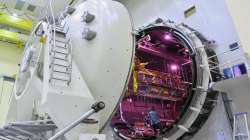NASA-ISRO Synthetic Aperture Radar likely to be launched in January: Know its aim and other key features
The NASA-ISRO Synthetic Aperture Radar (NISAR) is likely to be launched in January 2024 from the Satish Dhawan Space Centre in Sriharikota. The mission has a three-year duration and aims to survey the entire Earth's land and ice-covered surfaces every 12 days.

The NASA-ISRO Synthetic Aperture Radar (NISAR) is likely to be launched in the first quarter of 2024 after a few tests, especially those related to vibration. During a media interaction in Bengaluru on Wednesday, NASA NISAR Project Manager Phil Barela stated that the Indian Space Research Organisation (ISRO) is projecting the first quarter of next year. "So, I mean, that's ready," he added.
He anticipated that the ISRO Geosynchronous Satellite Launch Vehicle Mark-II will launch NISAR "not earlier than January" from the Satish Dhawan Space Centre in Sriharikota. The mission has a three-year duration and aims to survey the entire Earth's land and ice-covered surfaces every 12 days.
Regarding the pending key tests, Barela said that the vibration testing is underway, but there is a whole slew of performance tests that we need to do. He went on to say that the battery and simulation tests have to be done to make sure that the system works fine. "We will be doing performance testing on the radars and various spacecraft electronics. So, a lot of testing remains but the big environments test, the only one remaining now, is vibration," Barela said.
Some key features of NISAR:
- It is a Low Earth Orbit (LEO) observatory being jointly developed by ISRO and NASA.
- It will have a Synthetic Aperture Radar Instrument (SAR), L-band SAR, S-band SAR and Antenna reflector.
- The onboard instruments can even see a minor change of even one centimetre from space.
- The SUV-size satellite has a mass of roughly 2,800 kg.
- It will be powered by two solar arrays providing about four kilowatts of power.
- The six-foot-tall ‘spacecraft bus’ will contain the command and communication systems for the instrument payload.
- The ‘bus’ houses two SAR instruments and will also support the radar antenna reflector and its boom.
- There is enough fuel aboard to support at least five years of operations.
What NASA's Director of the Jet Propulsion Laboratory said?
Speaking about the project, Laurie Leshin, Director of the Jet Propulsion Laboratory, NASA, said that it is a radar machine to look at the surface of the earth and how it is changing. "...We are so excited to work on NISAR...In India, they are interested in understanding how the mangrove environment at the coasts is changing... We will understand how ice sheets are changing and how earthquakes and volcanoes are happening all over the world," she said.
"It has been so exciting to have our colleagues from JPL (Jet Propulsion Laboratory) here in Bengaluru working shoulder-to-shoulder with their colleagues at ISRO... The team is working very well together...We look forward to working together on all kinds of things, perhaps future missions to the Moon and Mars...," she added.
Aim of the project
It should be noted here that NISAR will map the entire globe in 12 days and provide spatially and temporally consistent data for understanding changes in the Earth's ecosystems, ice mass, vegetation biomass, sea level rise, groundwater and natural hazards, including earthquakes, tsunamis, volcanoes and landslides.
NASA also stated that the project aims to understand the dynamics of carbon storage and uptake in wooded, agricultural, wetland and permafrost ecosystems and the response of ice sheets to climate change, the interaction of sea ice and climate, and impacts on sea level rise worldwide.
(With inputs from agencies)
ALSO READ: Like never before! NASA shares breathtaking image of Earth's Aurora - SEE PIC
